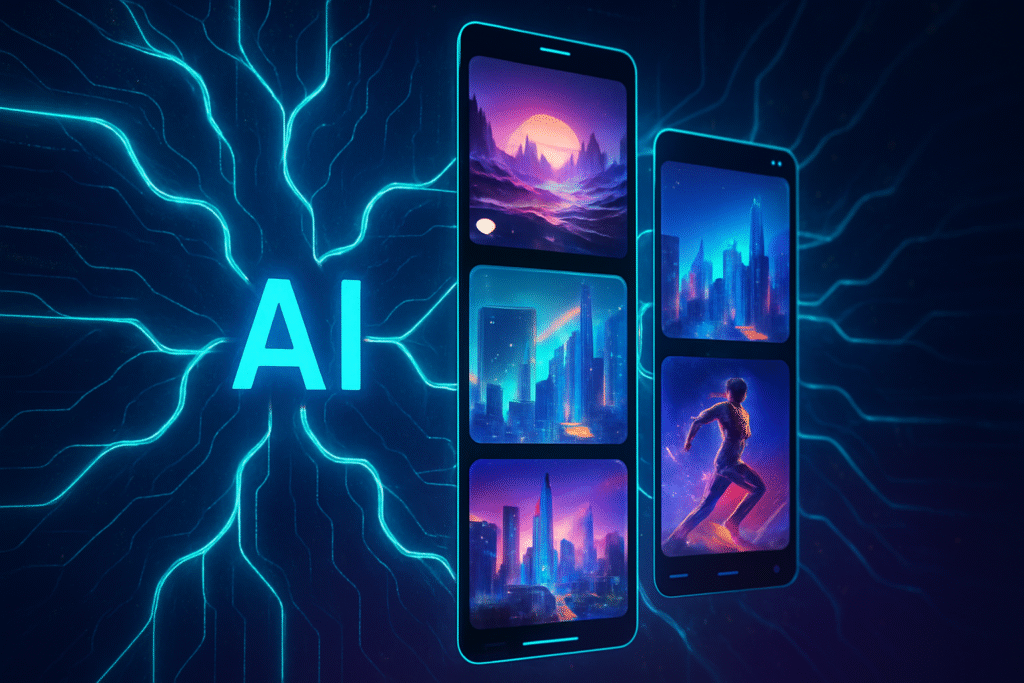
In a groundbreaking move that could fundamentally reshape the landscape of social media and AI-generated content, OpenAI has officially launched its new invite-only iOS application, simply named "Sora." Described by many as an "AI-powered TikTok clone," this innovative platform exclusively features short-form, AI-generated videos, marking a significant foray by the leading AI research company into consumer social media. The launch, occurring in early October 2025, immediately positions OpenAI as a formidable new player in the highly competitive short-video market, challenging established giants and opening up unprecedented avenues for AI-driven creativity.
The immediate significance of the Sora app cannot be overstated. It represents a bold strategic pivot for OpenAI, moving beyond foundational AI models to directly engage with end-users through a consumer-facing product. This initiative is not merely about showcasing advanced video generation capabilities; it's about creating an entirely new paradigm for social interaction, where the content itself is a product of artificial intelligence, curated and personalized to an extreme degree. The timing is particularly noteworthy, coinciding with ongoing geopolitical uncertainties surrounding TikTok's operations in key markets, potentially allowing OpenAI to carve out a substantial niche.
The Technical Marvel Behind Sora: A World Simulation Engine
At the heart of OpenAI's Sora application lies its sophisticated video generation model, Sora 2. Unveiled initially in February 2024 as a text-to-video model, Sora has rapidly evolved into what OpenAI describes as "world simulation technology." This advanced neural network leverages a deep understanding of language and physical laws to generate incredibly realistic and imaginative video content. Sora 2 excels at creating complex scenes with multiple characters, specific motions, and intricate details, demonstrating improved physics simulation capabilities that accurately model scenarios adhering to principles of buoyancy and rigidity. Beyond visuals, Sora 2 can also produce high-quality audio, including realistic speech, ambient soundscapes, and precise sound effects, creating a truly immersive AI-generated experience.
The Sora app itself closely mirrors the familiar vertical, swipe-to-scroll user interface popularized by TikTok. However, its most defining characteristic is its content exclusivity: all videos on the platform are 100% AI-generated. Users cannot upload their own photos or videos, instead interacting with the AI to create and modify content. Initially, generated videos are limited to 10 seconds, though the underlying Sora 2 model is capable of producing clips up to a minute in length. Unique features include a "Remix" function, enabling users to build upon and modify existing AI-generated videos, fostering a collaborative creative environment. A standout innovation is "Cameos," an identity verification tool where users can upload their face and voice, allowing them to appear in AI-generated content. Crucially, users retain full control over their digital likeness, deciding who can use their cameo and receiving notifications even for unposted drafts.
This approach differs dramatically from existing social media platforms, which primarily serve as conduits for user-generated content. While other platforms are exploring AI tools for content creation, Sora makes AI the sole content creator. Initial reactions from the AI research community have ranged from awe at Sora 2's capabilities to cautious optimism regarding its societal implications. Experts highlight the model's ability to mimic diverse visual styles, suggesting its training data included a vast array of content from movies, TikTok clips, and even Netflix shows, which explains its uncanny realism and stylistic versatility. The launch signifies a major leap beyond previous text-to-image or basic video generation models, pushing the boundaries of what AI can autonomously create.
Reshaping the Competitive Landscape: AI Giants and Market Disruption
OpenAI's entry into the social media arena with the Sora app sends immediate ripples across the tech industry, particularly impacting established AI companies, tech giants, and burgeoning startups. ByteDance, the parent company of TikTok, faces a direct and technologically advanced competitor. While TikTok (not publicly traded) boasts a massive existing user base and sophisticated recommendation algorithms, Sora's unique proposition of purely AI-generated content could attract a new demographic or provide an alternative for those seeking novel forms of entertainment and creative expression. The timing of Sora's launch, amidst regulatory pressures on TikTok in the U.S., could provide OpenAI with a strategic window to gain significant traction.
Tech giants like Meta Platforms (NASDAQ: META), with its Instagram Reels, and Alphabet (NASDAQ: GOOGL), with YouTube Shorts, also face increased competitive pressure. While these platforms have integrated AI for content recommendation and some creative tools, Sora's full-stack AI content generation model represents a fundamentally different approach. This could force existing players to accelerate their own AI content generation initiatives, potentially leading to a new arms race in AI-driven media. Startups in the AI video generation space might find themselves in a challenging position, as OpenAI's considerable resources and advanced models set a very high bar for entry and innovation.
Strategically, the Sora app provides OpenAI with a controlled environment to gather invaluable data for continuously refining future iterations of its Sora model. User interactions, prompts, and remix activities will feed directly back into the model's training, creating a powerful feedback loop that further enhances its capabilities. This move allows OpenAI to build a strategic moat, fostering a community around its proprietary AI technology and potentially discouraging users from migrating to competing AI video models. Critics, however, view this expansion as part of OpenAI's broader strategy to establish an "AI monopoly," consistently asserting its leadership in the AI industry to investors and solidifying its position across the AI value chain, from foundational models to consumer applications.
Wider Significance: Blurring Realities and Ethical Frontiers
The introduction of the Sora app fits squarely into the broader AI landscape as a pivotal moment, pushing the boundaries of AI's creative and interactive capabilities. It signifies a major step towards AI becoming not just a tool for content creation, but a direct creator and facilitator of social experiences. This development accelerates the trend of blurring lines between reality and artificial intelligence, as users increasingly engage with content that is indistinguishable from, or even surpasses, human-generated media in certain aspects. It underscores the rapid progress in generative AI, moving from static images to dynamic, coherent, and emotionally resonant video narratives.
However, this breakthrough also brings significant impacts and potential concerns to the forefront. Copyright infringement is a major issue, given that Sora's training data included vast amounts of existing media, and the AI has demonstrated the ability to generate content resembling copyrighted material. This raises complex legal and ethical questions about attribution, ownership, and the need for rights holders to actively opt out of AI training sets. Even more pressing are ethical concerns regarding the potential for deepfakes and the spread of misinformation. Despite OpenAI's commitment to safety, implementing parental controls, age-prediction systems, watermarks, and embedded metadata to indicate AI origin, the sheer volume and realism of AI-generated content could make it increasingly difficult to discern truth from fabrication.
Comparisons to previous AI milestones are inevitable. Just as large language models (LLMs) like GPT-3 and GPT-4 revolutionized text generation and understanding, Sora 2 is poised to do the same for video. It represents a leap akin to the advent of photorealistic AI image generation, but with the added complexity and immersive quality of motion and sound. This development further solidifies the notion that AI is not just automating tasks but is actively participating in and shaping human culture and communication. The implications for the entertainment industry, advertising, education, and creative processes are profound, suggesting a future where AI will be an omnipresent creative partner.
The Road Ahead: Evolving Applications and Lingering Challenges
Looking ahead, the near-term developments for the Sora app will likely focus on expanding its user base beyond the initial invite-only phase, iterating on features based on user feedback, and continuously refining the underlying Sora 2 model. We can expect to see increased video length capabilities, more sophisticated control over generated content, and potentially integration with other OpenAI tools or third-party APIs. The "Cameos" feature, in particular, holds immense potential for personalized content and virtual presence, which could evolve into new forms of digital identity and interaction.
In the long term, the applications and use cases on the horizon are vast. Sora could become a powerful tool for independent filmmakers, advertisers, educators, and even game developers, enabling rapid prototyping and content creation at scales previously unimaginable. Imagine AI-generated personalized news broadcasts, interactive storytelling experiences where users influence the narrative through AI prompts, or educational content tailored precisely to individual learning styles. The platform could also serve as a proving ground for advanced AI agents capable of understanding and executing complex creative directives.
However, significant challenges need to be addressed. The ethical frameworks around AI-generated content, especially concerning copyright, deepfakes, and responsible use, are still nascent and require robust development. OpenAI will need to continuously invest in its safety measures and content moderation to combat potential misuse. Furthermore, ensuring equitable access and preventing the exacerbation of digital divides will be crucial as AI-powered creative tools become more prevalent. Experts predict that the next phase will involve a deeper integration of AI into all forms of media, leading to a hybrid creative ecosystem where human and artificial intelligence collaborate seamlessly. The evolution of Sora will be a key indicator of this future.
A New Chapter in AI-Driven Creativity
OpenAI's launch of the Sora app represents a monumental step in the evolution of artificial intelligence and its integration into daily life. The key takeaway is that AI is no longer just generating text or static images; it is now capable of producing dynamic, high-fidelity video content that can drive entirely new social media experiences. This development's significance in AI history cannot be overstated, marking a clear transition point where generative AI moves from being a specialized tool to a mainstream content engine. It underscores the accelerating pace of AI innovation and its profound potential to disrupt and redefine industries.
The long-term impact of Sora will likely be multifaceted, encompassing not only social media and entertainment but also broader creative industries, digital identity, and even the nature of reality itself. As AI-generated content becomes more pervasive and sophisticated, questions about authenticity, authorship, and trust will become increasingly central to our digital interactions. OpenAI's commitment to safety features like watermarking and metadata is a crucial first step, but the industry as a whole will need to collaborate on robust standards and regulations.
In the coming weeks and months, all eyes will be on Sora's user adoption, the quality and diversity of content it generates, and how the platform addresses the inevitable ethical and technical challenges. Its success or struggles will offer invaluable insights into the future trajectory of AI-powered social media and the broader implications of generative AI becoming a primary source of digital content. This is not just another app; it's a glimpse into an AI-driven future that is rapidly becoming our present.
This content is intended for informational purposes only and represents analysis of current AI developments.
TokenRing AI delivers enterprise-grade solutions for multi-agent AI workflow orchestration, AI-powered development tools, and seamless remote collaboration platforms.
For more information, visit https://www.tokenring.ai/.





